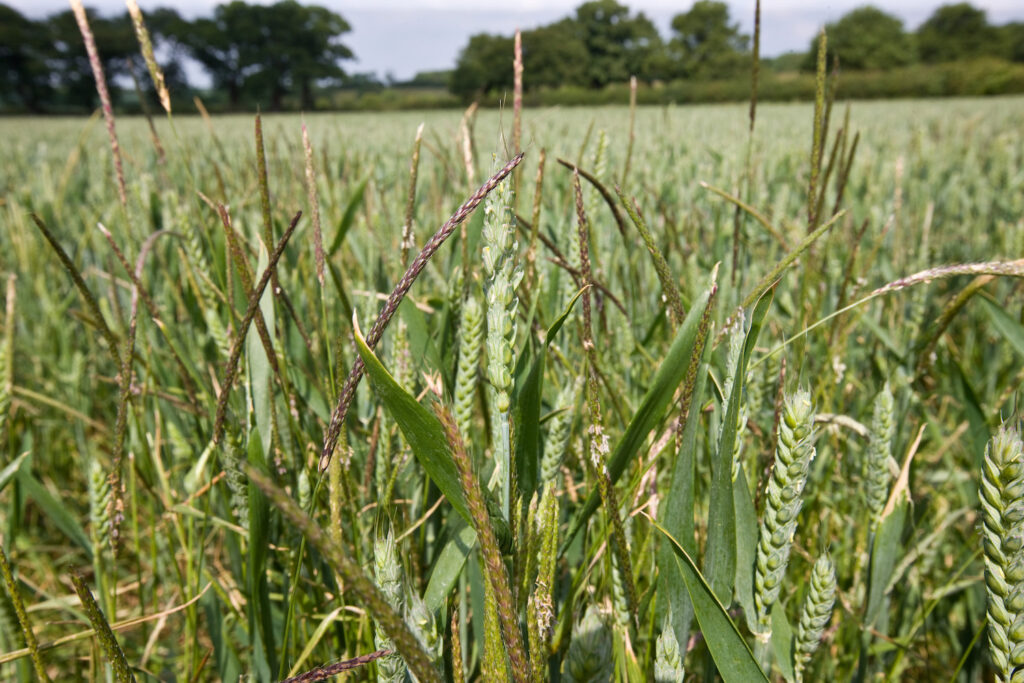Treat grassweeds “as soon as conditions allow”
25th January 2023
Grassweed burdens in winter wheat are higher than usual in many areas this season, leaving many fields requiring additional control measures to protect crop performance and reduce grass seed return to the soil.

Blackgrass in wheat. Image © Tim Scrivener
The problem has been caused by a variety of factors, says Agrovista technical manager Mark Hemmant.
“There was certainly a temptation to drill earlier last autumn, due to the early harvest and the fact that crops drilled earlier in autumn 2021 generally coped with the last year’s drought better than later-drilled ones. As a result, some growers with a grassweed problem started drilling too early, and the results are obvious to see.
“Others delayed sowing until mid-October after they had some rain. However, because it had been so dry beforehand, no grass weeds had emerged so they still had a heavy burden in their crops.
“In addition, in many cases it was still too dry for pre-emergence herbicides to perform as well as they should have done.”
Taking a long-term view
Quite a number of growers have applied second residuals since, which seem to be working well, Mark adds.
“However, there are plenty of instances where this hasn’t happened. And some fields may not warrant treatment in terms of protecting crop yield and quality. But we also have to take a long-term view on managing seed return to reduce the blackgrass burden within the rotation, and to tidy up ryegrass and bromes, where we haven’t got resistance.
“Some people think they have resistance, but testing often shows that often poor control is due to some other factor, such as poor weather or less-than-ideal application.”
“Don’t wait for the perfect weather”
No chemistry offers total control of blackgrass, so the best chance for optimum control post emergence is to spray when grass weeds are small, rather than waiting for the perfect weather.
February is an ideal month provided weeds are growing and the ground will travel. “Going early on if conditions are right is better than waiting – we might have prolonged rain or have an arctic blast for a month,” says Mark.
Operators should beware frosts and dews in winter/early spring as spray drying times are important, particularly with sulfonylurea (SU) products. “Be prepared to pick off fields here and there, perhaps applying individual tank loads to allow them to dry.”
For those who can go earlier, Horus (mesosulfuron and iodosulfuron) up to 1.2 litres/ha will do a good job in January in the right conditions on blackgrass, Mark advises. Where ryegrasses, brome or wild oats also need controlling, Palio or Broadway Star (florasulam, pyroxsulam and cloquintocet) would be a better option if conditions are suitable.
From 1st February, Pacifica Plus (mesosulfuron, iodosulfuron and amidosulfuron) can be used at 0.4kg/ha. Treatment can be stepped up further on 1st March when the full rate of 0.5kg/ha can be used, the optimum rate for brome control.
Newer active
However, over the past two years, from 1st February, Agrovista has been recommending Proverb, which contains mesosulfuron, iodosulfuron and thiencarbazone, a newer SU active offering better control.
“We recommend Proverb at 0.33kg/ha plus Biopower,” says Mark. “It’s not revolutionary, but it provides a useful step-up in control compared with products we have become more used to.
“As with all herbicides, good application is key. Apply where possible to young actively growing grassweeds in a fine/medium spray at 200-300 litres/ha water volume, and allow sufficient drying time.”
